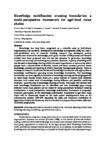Knowledge mobilisation crossing boundaries: A multi-perspective framework for agri-food value chains
| dc.contributor.author | Liu, S | en |
| dc.contributor.author | Zhao, G | en |
| dc.contributor.author | Chen, H | en |
| dc.contributor.author | Fernandez, A | en |
| dc.contributor.author | Torres, D | en |
| dc.contributor.author | Antonelli, L | en |
| dc.contributor.author | Panetto, H | en |
| dc.contributor.author | Lezoche, M | en |
| dc.date.accessioned | 2022-08-04T15:07:32Z | |
| dc.date.available | 2022-08-04T15:07:32Z | |
| dc.date.issued | 2021-06-04 | en |
| dc.identifier.issn | 0567-7572 | en |
| dc.identifier.uri | http://hdl.handle.net/10026.1/19491 | |
| dc.description.abstract |
Knowledge has long been recognized as a valuable asset to individuals, organisations and economy, subsequently knowledge management (KM) has been a well-established area of research. Existing research has developed various classification schemes for knowledge, and a great number of KM process and lifecycle models have been proposed over the last few decades. In particular, knowledge transfer and sharing has received great attention. However, majority of existing work has focused on knowledge sharing within the same organization or community where people have a shared sense of identity, values and some common practice, hence knowledge process and learning is within relatively homogeneous groups. There is inadequate research to address the issue of knowledge boundaries and approaches to knowledge mobilisation spanning across knowledge boundaries. The knowledge boundaries can erect significant barriers to knowledge sharing and flowing especially in value chain context where there are a great number of players from different domains, with varied level of knowledge, having different and possibly conflicting interests - participating in knowledge sharing activities. This paper will explore how such knowledge boundaries can be identified and how knowledge gaps among different value chain players can be closed by using appropriate boundary-crossing mechanisms. A multi-perspective knowledge mobilisation framework is proposed. Example applications of the knowledge mobilisation framework in agri-food value chain will be illustrated, based on the most recent developments from an EU collaborative project, RUC-APS (standing for Risk and Uncertain Conditions in Agriculture Production Systems), which is funded by European Commission's Horizon 2020 RISE program. | en |
| dc.format.extent | 185 - 199 | en |
| dc.language.iso | en | en |
| dc.title | Knowledge mobilisation crossing boundaries: A multi-perspective framework for agri-food value chains | en |
| dc.type | Conference Contribution | |
| plymouth.volume | 1311 | en |
| plymouth.publication-status | Published | en |
| plymouth.journal | Acta Horticulturae | en |
| dc.identifier.doi | 10.17660/ActaHortic.2021.1311.24 | en |
| plymouth.organisational-group | /Plymouth | |
| plymouth.organisational-group | /Plymouth/Faculty of Arts, Humanities and Business | |
| plymouth.organisational-group | /Plymouth/Faculty of Arts, Humanities and Business/Plymouth Business School | |
| plymouth.organisational-group | /Plymouth/REF 2021 Researchers by UoA | |
| plymouth.organisational-group | /Plymouth/REF 2021 Researchers by UoA/UoA17 Business and Management Studies | |
| plymouth.organisational-group | /Plymouth/Users by role | |
| plymouth.organisational-group | /Plymouth/Users by role/Academics | |
| dc.identifier.eissn | 2406-6168 | en |
| dc.rights.embargoperiod | Not known | en |
| rioxxterms.funder | European Commission | |
| rioxxterms.identifier.project | Enhancing and implementing Knowledge based ICT solutions within high Risk and Uncertain Conditions for Agriculture Production Systems | |
| rioxxterms.versionofrecord | 10.17660/ActaHortic.2021.1311.24 | en |
| rioxxterms.licenseref.uri | http://www.rioxx.net/licenses/all-rights-reserved | en |
| rioxxterms.type | Conference Paper/Proceeding/Abstract | en |
| plymouth.funder | Enhancing and implementing Knowledge based ICT solutions within high Risk and Uncertain Conditions for Agriculture Production Systems::European Commission | en |


